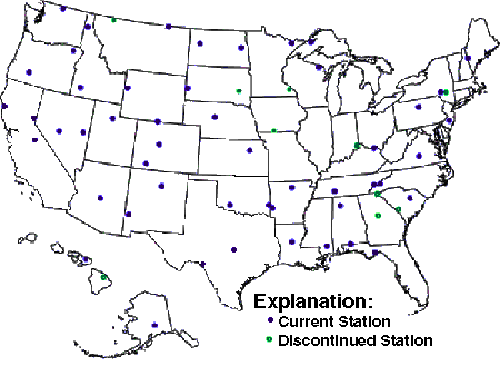

The Hydrologic Benchmark Network was established in 1963 to provide long-term measurements of streamflow and water quality in areas that are minimally affected by human activities. These data were to be used to study time trends and to serve as controls for separating natural from artificial changes in other streams. The network has consisted of as many as 58 drainage basins in 39 States. This report describes the environmental characteristics and water quality at 56 benchmark basins including 16 in the Eastern United States, 14 in the Midwestern United States, 14 in the West-Central United States, and 12 in the Western United States. The information in this report was compiled to aid in the application and interpretation of historical water-quality data collected as part of the U.S. Geological Survey Hydrologic Benchmark Network program.
The site characteristics vary amount the stations in the Hydrologic Benchmark Network. Land-use activities range from recreational use and timber harvesting on publicly owned land to agriculture and residential development on privately owned land. The streams drain a variety of physiographic, geologic, and ecologic settings that range from low-elevation coastal plain environments to high-elevation alpine environments. The streamflow characteristics of the stations are variable. Some of the sites are dominated by steady ground-water flows, and others have snow-dominated hydrographs where a large part of the flow results from the melting of the annual snowpack.
Stream-water chemistry at most Hydrologic Benchmark Network stations appears to be controlled by the interaction of acidic precipitation with underlying soils and bedrock. Land use has a minimal effect on stream-water chemistry except for a few stations in the Eastern and Midwestern regions of the United States. Temporal trends in water-quality constituents were observed at several of the stations and were attributed either to environmental or to method-related factors. Environmental factors that may have caused water-quality trends include increases in residential population, trends in atmospheric deposition, agricultural activities, landscape disturbance, and extended periods of drought. A few common trends were observed among stations, including downward trends in sulfate and upward trends in pH at several stations, which were attributed to changes in field instrumentation and analytical techniques rather than environmental change.
Click on a location on the map to view information about that station or click here for a list of all the HBN stations.

This page maintained by Nichole Bisceglia (nbiscegl@usgs.gov)
Last updated Thursday, July 27, 2000.
| AccessibilityFOIAPrivacyPolicies and Notices | |
 |
|